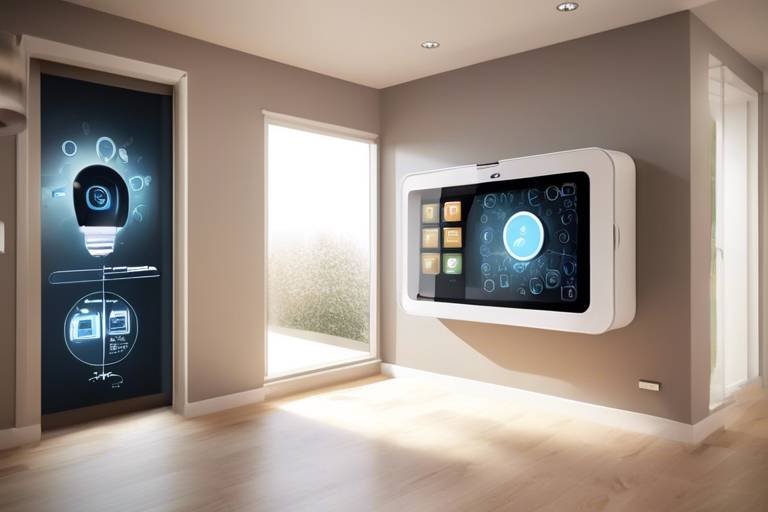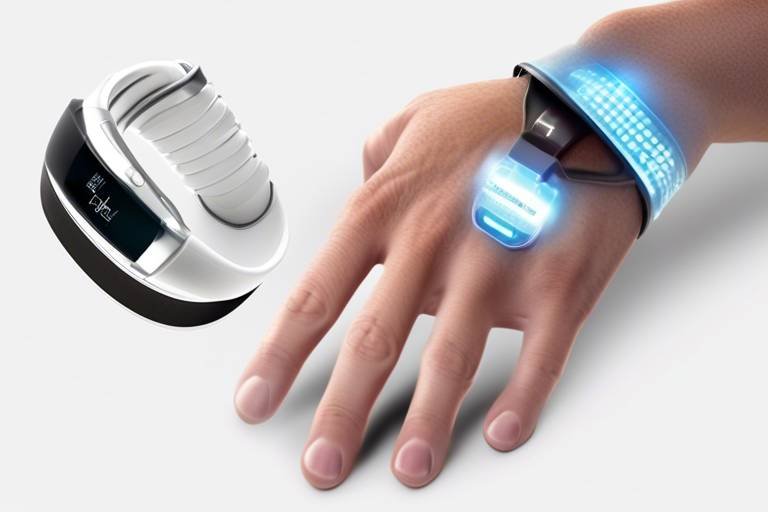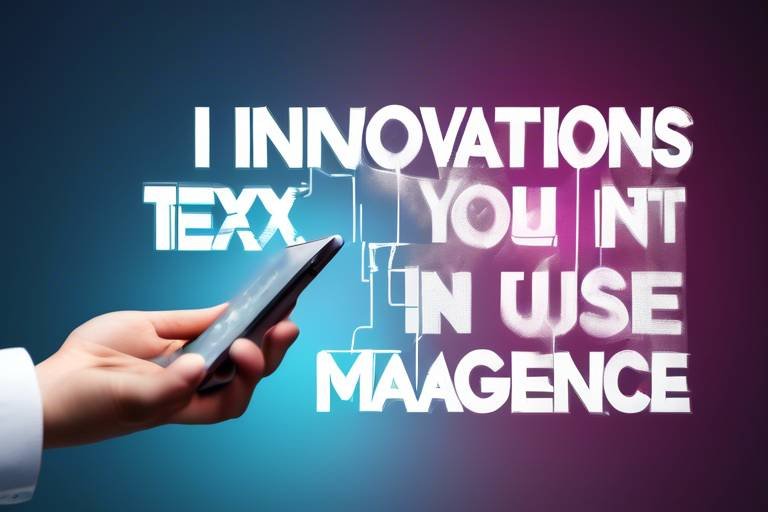The Role of Smart Devices in Modern Homes
In today's fast-paced world, the integration of smart devices into our homes is not just a trend; it's a revolution that is reshaping how we live. Imagine walking into your home and having the lights automatically adjust to your preferred brightness, the thermostat set to your ideal temperature, and your favorite music playing in the background—all without lifting a finger. This is the magic of smart home technology, where convenience meets innovation, enhancing our daily lives in ways we never thought possible.
At its core, smart home technology is about creating a connected living environment. It involves a network of devices that communicate with each other and can be controlled remotely, often through a smartphone app or voice commands. From smart refrigerators that help you manage your groceries to security systems that keep an eye on your property while you're away, the possibilities are endless. Each device plays a vital role in making our lives easier, safer, and more efficient.
One of the most appealing aspects of smart devices is their ability to provide automation. This means that routine tasks can be programmed to occur automatically, allowing us to focus on more important things in our lives. For instance, you can set your coffee maker to start brewing at a specific time every morning, so you wake up to the aroma of freshly brewed coffee. Or, you can schedule your smart blinds to open at sunrise, letting in natural light to energize your day. The convenience of such features is not just about luxury; it’s about reclaiming time and enhancing our overall quality of life.
Moreover, as we continue to embrace sustainability, smart devices also contribute significantly to energy efficiency. They allow homeowners to monitor their energy consumption patterns, helping to identify areas where they can save on utility bills. For example, smart thermostats can learn your heating and cooling preferences, adjusting settings automatically to optimize energy use. This not only reduces costs but also lowers our carbon footprint, making smart devices a crucial part of eco-friendly living.
As we delve deeper into the role of smart devices in modern homes, it becomes clear that they are not just gadgets; they are essential tools that enhance our lives in multiple dimensions. From improving convenience and security to promoting energy efficiency, the benefits are profound and far-reaching. Embracing smart technology means stepping into a future where our homes are not just places to live but are dynamic environments that support our lifestyles.
- What are smart devices? Smart devices are electronic devices that connect to the internet and can be controlled remotely, allowing users to manage various functions through apps or voice commands.
- How do smart home devices improve security? Smart home devices enhance security through features like real-time monitoring, alerts for unusual activities, and remote access control, giving homeowners peace of mind.
- Can smart devices help save energy? Yes! Smart devices enable homeowners to monitor and manage their energy consumption, leading to significant savings on utility bills.
- Are smart devices easy to install? Most smart devices are designed for easy installation and can often be set up without professional help, making them accessible to a wide audience.

Understanding Smart Home Technology
Smart home technology is revolutionizing the way we live, turning our traditional houses into intelligent living spaces. At its core, smart home technology comprises a variety of devices that communicate with each other over the internet, allowing homeowners to control and monitor their environment remotely. Imagine being able to adjust your thermostat, turn on lights, or even unlock your front door from anywhere in the world – that’s the magic of smart home technology!
The primary components of a smart home system include smart devices, a central hub or controller, and a reliable internet connection. Smart devices can range from simple gadgets like smart bulbs to more complex systems like smart security cameras. These devices often use wireless communication protocols such as Wi-Fi, Zigbee, or Z-Wave to interact with each other and the central hub, creating a seamless network of interconnected devices.
To put it simply, think of the central hub as the brain of your smart home. It coordinates the actions of all connected devices, ensuring they work together harmoniously. For instance, when you leave for work, you can set your hub to lock the doors, turn off the lights, and adjust the thermostat to save energy. This level of integration not only enhances convenience but also promotes energy efficiency, making your home smarter and more sustainable.
One of the standout features of smart home technology is its ability to learn and adapt to your habits. Many smart devices come equipped with machine learning algorithms that analyze your daily routines and make adjustments accordingly. For example, a smart thermostat may learn when you typically leave for work and adjust the temperature to save energy while you're away. This kind of automation not only simplifies your life but also helps reduce your energy bills.
Moreover, the user interface for controlling these devices has evolved significantly. Most smart home systems can be managed through mobile apps, allowing you to monitor and control your home from the palm of your hand. Some systems even support voice commands through devices like Amazon Alexa or Google Assistant, making it easier than ever to interact with your home. Just imagine saying, “Hey Google, turn off the living room lights,” and having it done instantly – it’s like having a personal assistant at your service!
In summary, understanding smart home technology involves recognizing the interconnectedness of devices, the role of a central hub, and the benefits of automation and user-friendly interfaces. As we continue to embrace this technology, our homes are becoming more than just living spaces; they are evolving into smart ecosystems that enhance our quality of life.

Benefits of Smart Devices
In today's fast-paced world, the integration of smart devices into our homes is not just a luxury; it's becoming a necessity. These gadgets are designed to make our lives easier, more efficient, and even safer. Imagine coming home after a long day, and with just a simple voice command, your house lights up, your favorite playlist starts playing, and the thermostat adjusts to your preferred temperature. This level of convenience is just one of the many benefits that smart devices bring to modern living.
One of the standout advantages of smart technology is its ability to provide energy savings. Smart devices are equipped with features that enable homeowners to monitor their energy consumption patterns closely. For instance, smart thermostats learn your schedule and adjust heating and cooling automatically, ensuring that energy is not wasted when you’re not at home. According to recent studies, households that utilize smart thermostats can save up to 15% on their energy bills. This not only helps the environment but also puts more money back into your pocket.
Additionally, the enhanced security features offered by smart devices cannot be overstated. Homeowners can now monitor their properties in real-time, receive alerts about unusual activities, and even control access to their homes remotely. With the rise in smart cameras and sensors, you can have peace of mind knowing that your home is under constant surveillance, even when you're away. This level of security is a game-changer, especially for families with children or elderly members who may need extra protection.
Furthermore, the automation capabilities of smart devices streamline daily tasks, making life easier and more enjoyable. For example, smart lighting solutions allow you to customize your home’s ambiance effortlessly. You can set schedules for your lights to turn on and off, adjust brightness, or even change colors to match your mood—all from your smartphone or through voice commands. This not only enhances your living space but also allows you to create a cozy atmosphere for gatherings or a calming environment for relaxation.
To summarize, the benefits of smart devices in our homes can be categorized into several key areas:
- Convenience: Automate daily tasks and control your home with ease.
- Energy Efficiency: Save on energy bills and contribute to a greener planet.
- Enhanced Security: Keep your home safe with real-time monitoring and alerts.
As technology continues to evolve, the integration of smart devices in our homes will only become more prevalent. Embracing these advancements not only improves our quality of life but also prepares us for a future where our homes are more connected and responsive to our needs.
Q1: What are smart devices?
A1: Smart devices are electronic gadgets that connect to the internet and can be controlled remotely through smartphones, tablets, or voice commands. They include smart thermostats, lights, cameras, and more.
Q2: How do smart devices enhance home security?
A2: Smart devices like cameras and sensors provide real-time monitoring and alerts for unusual activities, allowing homeowners to respond quickly to potential threats.
Q3: Can smart devices really save on energy bills?
A3: Yes! Smart devices, especially smart thermostats, can learn your habits and optimize energy usage, leading to significant savings on energy bills.
Q4: Are smart devices easy to install?
A4: Most smart devices are designed for easy installation, often requiring minimal tools and technical knowledge. Many come with user-friendly apps that guide you through the setup process.

Convenience and Automation
In today's fast-paced world, convenience is king, and smart devices are the royal subjects that make our lives easier. Imagine waking up in the morning and having your coffee brewed, your blinds opened, and your favorite playlist softly playing in the background—all without lifting a finger. This is not a scene from a futuristic movie; it's the reality that smart home technology brings to our daily routines. With the power of automation, smart devices allow us to control various aspects of our homes remotely, transforming mundane tasks into effortless experiences.
At the heart of this convenience is the ability to automate daily routines. For example, you can set your smart thermostat to adjust the temperature at specific times, ensuring that your home is always comfortable when you arrive. Similarly, smart lighting systems can be programmed to turn on and off at certain hours, or even to mimic your presence at home when you're away, adding an extra layer of security. The beauty of automation lies in its versatility; you can tailor it to fit your unique lifestyle and preferences.
One of the most exciting features of smart devices is their integration with voice assistants. These digital companions, like Amazon's Alexa or Google Assistant, allow for hands-free control of your smart home ecosystem. Just think about it—no more fumbling with switches or apps! You can simply say, "Turn on the living room lights," and voila! The lights respond instantly. This level of interaction not only simplifies your life but also makes it more enjoyable. The ability to control your environment with your voice is akin to having your own personal butler, ready to assist you at a moment's notice.
Moreover, smart lighting solutions take convenience to another level. With a mobile app or voice command, you can adjust the brightness and color of your lights, creating the perfect ambiance for any occasion. Want to host a cozy movie night? Dim the lights and switch to a warm hue with just a few words or taps. Need bright lighting for a work-from-home session? No problem! The flexibility of smart lighting means you can easily adapt your space to suit your needs.
In addition to lighting and climate control, smart devices can also automate security features. For instance, you can set your smart security cameras to start recording when motion is detected, ensuring that you never miss a moment. You can even receive alerts on your smartphone if unusual activity is detected, allowing you to stay informed about what’s happening at home, no matter where you are. The integration of convenience and automation in smart devices is a game-changer, making our homes not just smarter, but also safer and more comfortable.
In conclusion, the convenience and automation provided by smart devices are reshaping how we interact with our homes. By streamlining daily tasks and offering seamless control through voice commands and apps, these technologies are not just enhancing our lifestyles—they're revolutionizing them. So, why not embrace the future and let smart technology take some of the burdens off your shoulders?
- What are smart devices? Smart devices are electronic devices that connect to the internet and can be controlled remotely, often through a smartphone app or voice commands.
- How do smart devices enhance convenience? They automate daily tasks, allow remote control, and can be integrated with voice assistants for hands-free operation.
- Are smart devices secure? While they offer enhanced security features, it's essential to keep them updated and use strong passwords to protect against potential vulnerabilities.
- Can I control smart devices when I'm not home? Yes, most smart devices can be controlled remotely via their respective apps, allowing you to manage your home from anywhere.

Voice Assistants
Voice assistants have revolutionized the way we interact with our homes, making everyday tasks feel like a breeze. Imagine walking into your house after a long day, and with just a simple phrase, your lights turn on, your favorite playlist starts playing, and the thermostat adjusts to your preferred temperature. This isn’t the stuff of science fiction; it’s the reality of voice-activated technology! Voice assistants like Amazon’s Alexa, Google Assistant, and Apple’s Siri have become the central hub of smart home ecosystems, allowing users to control various devices through voice commands, thus enhancing the overall convenience of modern living.
The beauty of voice assistants lies in their ability to integrate seamlessly with a plethora of smart devices. They act as the brain of your smart home, coordinating everything from your lighting to your security systems. For instance, you can say, “Hey Google, lock the front door,” and just like that, your smart lock engages, giving you peace of mind without having to lift a finger. This level of automation not only saves time but also allows you to multitask effectively, whether you’re cooking dinner, working from home, or simply relaxing on the couch.
Additionally, voice assistants come equipped with advanced features that cater to individual preferences. You can customize them to recognize different voices, allowing family members to receive personalized responses. Want to know the weather? Just ask! Need a reminder for your next appointment? A quick voice command can set that up. The possibilities are endless, and that’s what makes these devices so appealing.
Moreover, voice assistants are continuously evolving, with updates and new features being added regularly. They can now control a wide range of devices, including smart lights, thermostats, security cameras, and even appliances like coffee makers and microwaves. This integration creates a cohesive smart home environment where everything works together in harmony.
However, while the convenience is undeniable, it’s essential to consider privacy concerns. Many users wonder how secure their conversations are and whether their data is being collected. Most major voice assistant providers have taken steps to enhance privacy, allowing users to review and delete their voice recordings. It’s crucial to stay informed and take necessary precautions to protect your personal information while enjoying the benefits of these fantastic technologies.
In summary, voice assistants are not just a luxury; they are becoming an essential part of modern living, transforming houses into smart homes. With their ability to simplify tasks through voice commands, they enhance convenience, improve efficiency, and provide an overall better quality of life. As technology continues to advance, we can only imagine the incredible features that will emerge, making our homes even smarter and our lives even easier.

Smart Lighting Solutions
Imagine walking into your home and having the lights automatically adjust to your preferred brightness and color, all without lifting a finger. have revolutionized the way we illuminate our spaces, seamlessly blending technology with our daily routines. These innovative systems allow homeowners to control lighting through mobile apps or voice commands, creating an ambiance that suits any occasion. Whether you're hosting a dinner party, enjoying a cozy movie night, or simply winding down after a long day, smart lighting can transform your environment with just a few taps or a simple voice command.
One of the most appealing aspects of smart lighting is its ability to customize settings according to your lifestyle. For instance, you can program your lights to gradually brighten in the morning, mimicking a natural sunrise, which can help you wake up more gently. Conversely, you can set them to dim in the evening, signaling it's time to relax. This level of control not only enhances your comfort but also contributes to your overall well-being.
Moreover, smart lighting solutions can be integrated with other smart home devices, creating a comprehensive ecosystem that communicates and responds to your needs. For example, when you activate your home security system, your smart lights can flash to alert you of any unusual activity. This interconnectedness adds an extra layer of security and convenience to your home.
Additionally, many smart lighting systems offer energy-efficient options, such as LED bulbs that consume less power while providing the same level of brightness as traditional bulbs. By monitoring your lighting usage through a mobile app, you can gain insights into your energy consumption patterns and make informed decisions to reduce costs. Imagine being able to set schedules for your lights to ensure they’re only on when needed, or even turning them off remotely if you forget to do so before leaving the house!
In summary, smart lighting solutions not only enhance the aesthetic appeal of your home but also offer practical benefits that align with modern living. From energy savings to personalized settings, these systems are designed to elevate your daily experiences. So, if you haven't yet embraced the world of smart lighting, now might be the perfect time to consider how it can brighten your life—literally and figuratively!

Energy Efficiency and Savings
In today's world, where every penny counts and environmental awareness is on the rise, energy efficiency has become a buzzword that resonates with homeowners. Smart devices are at the forefront of this movement, revolutionizing how we consume energy in our homes. Imagine a world where your home not only conserves energy but also saves you money on utility bills. Sounds appealing, right? Well, that’s exactly what smart technology offers!
Smart devices, such as smart thermostats, smart plugs, and energy monitoring systems, work together to optimize your energy usage. For instance, a smart thermostat can learn your schedule and adjust the temperature accordingly, ensuring that your heating or cooling system operates only when needed. This not only enhances comfort but also significantly reduces energy consumption. According to studies, homeowners can save up to 30% on heating and cooling costs by using smart thermostats!
Furthermore, smart plugs allow you to monitor the energy consumption of individual devices. You can track which appliances are energy hogs and make informed decisions about usage. For example, if you discover that your old refrigerator is consuming more energy than it should, you might consider upgrading to a more energy-efficient model. The ability to monitor and control energy usage empowers homeowners to make changes that lead to substantial savings.
Additionally, many smart home systems come equipped with energy management features. These features analyze your energy consumption patterns and provide insights on how to reduce waste. You can set schedules for when devices should operate, ensuring that they are not running unnecessarily. For example, you can program your smart lights to turn off automatically when you leave home or adjust their brightness based on the time of day. This level of control is not just convenient; it translates into real savings.
To illustrate the potential savings, consider the following table that highlights the average savings from various smart devices:
| Smart Device | Average Annual Savings |
|---|---|
| Smart Thermostat | $180 |
| Smart Lighting | $100 |
| Smart Plugs | $75 |
| Energy Monitoring Systems | $50 |
As you can see, the cumulative savings from these devices can add up to a significant amount over time. Not only are you saving money, but you’re also contributing to a greener planet by reducing your carbon footprint. It’s a win-win situation!
In conclusion, integrating smart devices into your home is not just about convenience; it’s a smart financial decision. By improving energy efficiency, these devices help you save money and promote sustainable living. So, why not take the leap into the future and make your home smarter? Your wallet and the environment will thank you!
- What are smart devices? Smart devices are electronic gadgets that connect to the internet and can be controlled remotely, often through a smartphone application.
- How do smart devices save energy? They optimize energy usage by allowing users to monitor and control their consumption, automate schedules, and adjust settings based on personal habits.
- Are smart devices expensive to install? While the initial investment can be higher, the long-term savings on energy bills often outweigh the costs, making them a worthwhile investment.
- Can I control smart devices when I'm not home? Yes! Most smart devices can be controlled remotely through their respective mobile apps, allowing you to manage your home from anywhere.

Enhancing Home Security
In today's world, the importance of home security cannot be overstated. With the rise in smart technology, homeowners are now equipped with a plethora of options to ensure their homes are safe and secure. Smart devices significantly bolster home security by providing real-time monitoring, instant alerts, and automated responses to potential threats. Imagine being able to check on your home from anywhere in the world, all from the convenience of your smartphone. This level of control not only enhances your peace of mind but also deters potential intruders.
One of the standout features of smart home security is the integration of smart cameras and sensors. These devices offer advanced surveillance capabilities, allowing homeowners to monitor their properties remotely. With high-definition video feeds and night vision, you can keep an eye on your home 24/7. Additionally, many smart cameras come equipped with motion detection technology that sends alerts to your phone whenever unusual activity is detected. This means you can react swiftly to any potential threats, whether it’s a package delivery or something more concerning.
Moreover, smart locks and access control systems take home security to the next level. These devices allow homeowners to control who enters their home with just a few taps on their smartphone. Forget about traditional keys that can be lost or stolen; smart locks offer features like temporary access codes for guests or service personnel. This means you can grant entry to a friend while you’re at work or let in a maintenance worker without needing to be physically present. The convenience and enhanced security provided by these systems are truly game-changing.
To illustrate the effectiveness of smart home security devices, consider the following table that compares traditional security measures with smart technology:
| Feature | Traditional Security | Smart Security |
|---|---|---|
| Real-time Monitoring | No | Yes |
| Remote Access | No | Yes |
| Instant Alerts | Delayed | Immediate |
| Access Control | Physical Keys | Smartphone App |
As you can see, the advantages of smart home security systems are clear. They not only provide enhanced protection but also offer a level of convenience that traditional systems simply cannot match. With the ability to monitor your home from anywhere, receive instant notifications, and control access remotely, smart devices are revolutionizing how we think about home security.
- How do smart cameras work? Smart cameras connect to your home Wi-Fi network, allowing you to view live footage from your smartphone or tablet. They often include features like motion detection and night vision.
- Are smart locks safe? Yes, smart locks use advanced encryption technology to protect against hacking. Additionally, many offer features like two-factor authentication for added security.
- Can I integrate smart security devices with other smart home systems? Absolutely! Most smart security devices can be integrated with other smart home systems, such as lighting and voice assistants, for a seamless experience.

Smart Cameras and Sensors
In today's fast-paced world, security has become a paramount concern for homeowners. This is where step in, acting as vigilant guardians of our living spaces. Imagine being able to monitor your home from anywhere in the world, receiving real-time alerts on your smartphone whenever something unusual occurs. With smart cameras and sensors, this is not just a dream—it's a reality. These devices are designed to integrate seamlessly into your home, providing a robust layer of security that traditional systems simply can't match.
Smart cameras come equipped with advanced features that enhance surveillance capabilities. For instance, many models offer high-definition video, night vision, and even two-way audio, allowing you to communicate with anyone on your property directly through the camera. This means that if a delivery person arrives while you're at work, you can greet them or instruct them on where to leave your package—all from the convenience of your smartphone. Furthermore, smart cameras often include motion detection technology, which triggers alerts when movement is detected, helping you stay informed about any potential intrusions.
But it's not just about cameras; smart sensors are equally important in the security ecosystem. These devices can detect a variety of conditions, such as:
- Motion
- Sound
- Temperature changes
- Smoke and carbon monoxide
By utilizing these sensors, homeowners can receive instant notifications if there’s an unexpected change in their environment. For example, if a window is opened when it shouldn't be, or if smoke is detected in the kitchen, the system can alert you immediately, allowing you to take action before a situation escalates.
Moreover, many smart security systems allow for integration with other smart home devices. This means that when a camera detects motion, it can trigger smart lights to turn on, illuminating the area and potentially deterring any would-be intruders. This level of automation not only enhances security but also provides a sense of control and peace of mind.
As technology continues to evolve, the capabilities of smart cameras and sensors are only expected to improve. Features like AI-driven facial recognition and advanced analytics will make these devices even more effective in distinguishing between normal activities and potential threats. The future of home security is not just about surveillance; it’s about intelligent systems that learn and adapt, providing homeowners with an unmatched level of safety.
In summary, smart cameras and sensors are revolutionizing home security. They offer a combination of convenience, real-time monitoring, and proactive alerts that traditional systems simply cannot provide. By integrating these devices into your home, you can transform your living space into a smart haven, where safety is prioritized, and you have the power to monitor your environment at your fingertips.
- How do smart cameras work? Smart cameras connect to your home Wi-Fi network, allowing you to view live video feeds and receive alerts via a mobile app.
- Can I access my smart camera remotely? Yes, most smart cameras allow remote access through mobile applications, enabling you to monitor your home from anywhere.
- What happens if my Wi-Fi goes down? Many smart cameras have local storage options, allowing them to continue recording even if the internet connection is lost.
- Are smart cameras secure? While no device is completely immune to hacking, reputable brands implement strong encryption and security protocols to protect your data.

Smart Locks and Access Control
In the ever-evolving world of technology, smart locks have emerged as a game-changer in home security and access control. Imagine arriving home with your hands full of groceries, and instead of fumbling for your keys, you simply approach your front door, and it unlocks automatically. This is just one of the many conveniences that smart locks offer. These devices not only enhance security but also provide a level of flexibility and control that traditional locks simply can't match.
Smart locks operate through a variety of methods, including smartphone apps, key fobs, and even voice commands. This means that you can lock or unlock your door from virtually anywhere, giving you peace of mind when you’re away from home. For instance, if you receive a call from a friend who needs to drop by while you’re at work, you can grant them access remotely without needing to rush home. This feature is particularly beneficial for busy families or those who frequently entertain guests.
Additionally, many smart locks come equipped with temporary access codes or digital keys that allow you to share access with others without compromising your security. This means that you can provide a one-time code for a service person or a friend, ensuring that they can enter your home without needing to hand over a physical key. Once their access is no longer needed, you can simply revoke it with a few taps on your smartphone.
Moreover, smart locks often integrate with other smart home devices, creating a cohesive security system. For instance, when your smart lock is engaged, it can signal your smart lighting to turn on, making it appear as if someone is home, even when you’re away. This integration not only enhances security but also contributes to energy efficiency by ensuring that lights are only on when necessary.
To give you a clearer picture of how smart locks compare to traditional locks, here’s a quick overview:
| Feature | Smart Locks | Traditional Locks |
|---|---|---|
| Remote Access | Yes | No |
| Temporary Access Codes | Yes | No |
| Integration with Smart Home Systems | Yes | No |
| Keyless Entry | Yes | Depends on Key |
| Audit Trails | Yes | No |
As you can see, smart locks not only provide enhanced security features but also offer a level of convenience that traditional locks simply cannot compete with. The ability to monitor access and receive alerts when someone enters or exits your home adds an extra layer of safety, ensuring that you are always in control. In a world where convenience and security go hand in hand, smart locks are paving the way for a more secure and streamlined living experience.
- What happens if the battery in my smart lock dies? Most smart locks have a backup key option, allowing you to unlock the door manually. Additionally, some models have a low-battery alert feature.
- Can I still use my traditional keys with a smart lock? Yes, many smart locks come with a physical key option, so you can use both methods of entry.
- How secure are smart locks? Smart locks utilize encryption and other security measures to protect against unauthorized access, making them very secure when properly installed and maintained.
Frequently Asked Questions
- What are smart devices and how do they work?
Smart devices are electronic gadgets that connect to the internet and can be controlled remotely. They work by using sensors, software, and connectivity to communicate with other devices and systems in your home, creating a seamless and automated living environment.
- How can smart devices improve my home’s energy efficiency?
Smart devices enhance energy efficiency by allowing you to monitor and manage your energy usage in real-time. For instance, smart thermostats can learn your schedule and adjust heating and cooling accordingly, while smart lighting can turn off automatically when you leave a room, helping to reduce energy costs.
- Are smart devices secure?
While smart devices can enhance security through features like real-time monitoring and alerts, they can also be vulnerable to hacking if not properly secured. It's essential to use strong passwords, keep your devices updated, and utilize security features like two-factor authentication to protect your home network.
- Can I control smart devices with my voice?
Absolutely! Many smart devices are compatible with voice assistants like Amazon Alexa or Google Assistant, allowing you to control them using simple voice commands. This hands-free convenience makes managing your home easier and more efficient.
- What types of smart devices are available for home security?
There are several smart devices designed specifically for home security, including smart cameras, motion sensors, smart locks, and doorbell cameras. These devices work together to provide comprehensive monitoring and control over your home’s security.
- Do smart devices require a lot of maintenance?
Most smart devices require minimal maintenance. Regular software updates are essential for security and performance, and occasionally, you may need to clean or check the devices to ensure they are functioning correctly. Overall, they are designed to be user-friendly and low-maintenance.
- Can I integrate different brands of smart devices?
Yes! Many smart devices from different brands can be integrated into a single system, especially if they are compatible with common smart home platforms like Apple HomeKit, Google Home, or Amazon Alexa. This allows you to create a cohesive smart home experience.
- What are the costs associated with setting up a smart home?
The costs can vary widely depending on the devices you choose and the size of your home. Basic setups can start at a few hundred dollars, while more comprehensive systems with advanced features can run into the thousands. It's essential to plan your budget according to your needs and priorities.



















